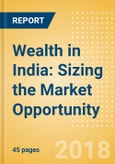Summary
The outlook is positive for the Indian wealth market, with performance over the coming five years set to improve on the previous five. India’s economy is performing strongly, with reforms such as the goods and services tax starting to take effect and encourage growth. While there are challenges - including the weak rupee and high oil prices - the positive momentum is expected to continue into 2019. All asset classes continue to attract inflows, with mutual funds experiencing particularly strong growth in the wake of a high-profile awareness-building campaign. While there is the noted non-resident Indian market, beyond this the retail non-resident market is limited, with foreign investors only able to access Indian equity markets and mutual funds as of 2012.
This report analyzes India’s wealth and retail savings and investments markets, with a focus on the HNW segment. The report is based on our proprietary datasets.
Specifically the report -
Scope
Reasons to Buy
The outlook is positive for the Indian wealth market, with performance over the coming five years set to improve on the previous five. India’s economy is performing strongly, with reforms such as the goods and services tax starting to take effect and encourage growth. While there are challenges - including the weak rupee and high oil prices - the positive momentum is expected to continue into 2019. All asset classes continue to attract inflows, with mutual funds experiencing particularly strong growth in the wake of a high-profile awareness-building campaign. While there is the noted non-resident Indian market, beyond this the retail non-resident market is limited, with foreign investors only able to access Indian equity markets and mutual funds as of 2012.
This report analyzes India’s wealth and retail savings and investments markets, with a focus on the HNW segment. The report is based on our proprietary datasets.
Specifically the report -
- Sizes the affluent market (both by number of individuals and the value of their assets) using proprietary datasets.
- Examines HNW clients’ attitudes towards non-liquid asset classes such as property, commodities, and offshore investments.
- Analyzes which asset classes are favored by Indian investors and how their preferences impact the growth of the total savings and investments market.
- Evaluates the size of the retail non-resident offshore market in India and foreign investors’ preferences.
Scope
- The affluent population is rebounding, with growth over the next five years set to exceed that of the last five. A compound annual growth rate of 12.6% is forecast between 2018 and 2022, bringing the number of affluent individuals to just under 12 million.
- The retail savings and investments market has a significant direct equity component, which accounted for 30.2% of total retail holdings in 2017. However, efforts to highlight mutual fund investing combined with the possible introduction of caps on direct equity investing by retail investors could see equities lose out to mutual funds in the long term.
- The non-resident investment market is small. Non-resident deposits only account for 6.9% of the total retail market (4.0% for mutual funds). There are a number of restrictions on non-resident holdings, and for overseas investors looking to gain exposure to India there are credible alternatives.
Reasons to Buy
- Benchmark your share of India’s wealth market against the current market size.
- Forecast your future growth prospects using our projections for the market to 2022.
- Identify your most promising client segment by analyzing the penetration of affluent individuals in India.
- Evaluate your HNW proposition by understanding how the ever-changing tax system affects your HNW clients.
- Review your offshore strategy and offering for non-resident investors by learning the dynamics in these markets.
Table of Contents
1. EXECUTIVE SUMMARY
2. INDIA’S WEALTH MARKET IS SET FOR STRONG GROWTH
3. INDIA’S RETAIL SAVINGS AND INVESTMENTS MARKET WILL CONTINUE ITS STRONG GROWTH TRAJECTORY
4. INDIA’S NON-RESIDENT INVESTMENT MARKET IS LIMITED
5. APPENDIX
List of Tables
List of Figures
Samples

LOADING...








